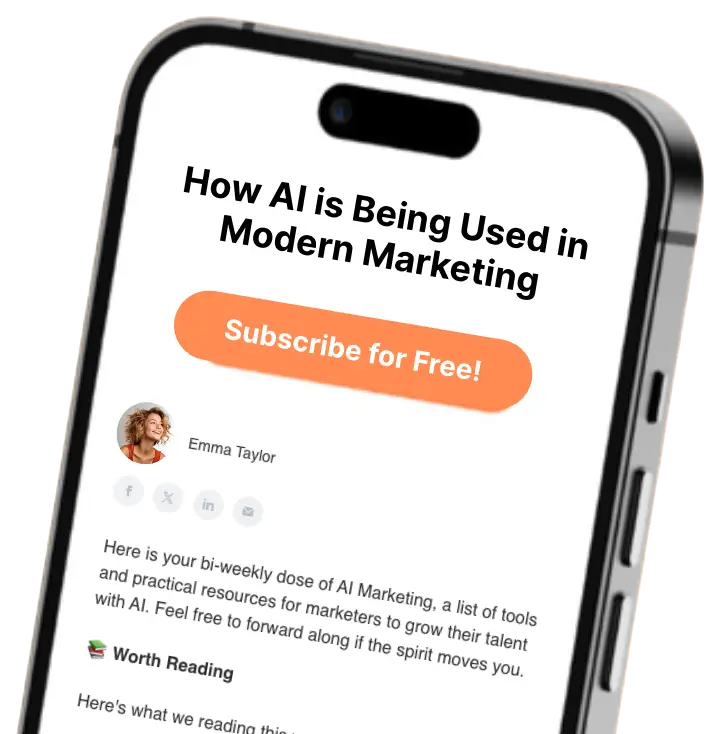Common B2B AI Marketing Questions Answered by Experts
AI is changing B2B marketing by improving targeting, automating tasks, and analyzing data in real time. Let’s tackle some of the most common questions.
1. What are the Benefits and Challenges of AI?
Some of the most frequently cited benefits include:
Better Targeting: Predictive analytics and AI tools like Salesforce Einstein increase lead quality by 40%.
Higher Engagement: AI-driven personalization boosts page views by 3-7x and session durations by 7.3x.
Efficiency Gains: Tools like HubSpot AI reduce email creation time by 60% and automate 60-70% of manual tasks.
Improved ROI: Companies using AI see 5:1 ROI and 20-30% higher lead conversion rates.
Challenges include data management issues (96% of companies face data problems), team skill gaps, and ethical concerns like AI bias and data privacy compliance. Solutions involve unified data platforms, training programs, and clear governance protocols.
2. How is AI Being Used for B2B Marketing Personalization?
Predictive Analytics in Customer Targeting
Predictive analytics powered by AI is changing how B2B companies find and connect with top prospects. By leveraging CRM data and analyzing various data points, these systems help pinpoint which accounts are most likely to convert.
Today’s predictive systems do more than just sort by demographics. For example, Seamless.AI evaluates over 50 different company signals to create detailed account profiles [1]. These signals include:
- Behavioral: Website activity, content downloads
- Historical: Previous purchases, support tickets
- Engagement: Email replies, meeting participation
This level of targeting calls for content that matches its sophistication – and that’s where AI-driven personalization tools come in.
AI Content Personalization Tools
Creating tailored content for precise targeting is now easier with advanced AI tools. For instance, Certinia used AI-powered content personalization to achieve notable results: 3.9x more page views and 7.3x longer web sessions [2].
HubSpot’s Campaign Assistant simplifies personalized outreach, cutting email creation time by 60% without sacrificing quality [1]. The platform’s AI analyzes factors like:
Behavioral trends
Industry-specific challenges
Customer journey stages
According to Forrester, programs that fully integrate AI across marketing touchpoints can achieve a 5:1 ROI by boosting engagement and speeding up sales cycles [5]
3. What are Common AI Implementation Challenges?
Data Management Problems
For B2B companies, data quality is the biggest hurdle when adopting AI marketing tools. In fact, 96% of organizations encounter data-related issues [12]. One of the most common problems is fragmented customer data, with 35% of companies struggling due to siloed information spread across multiple CRM systems [2].
To tackle this, many businesses are turning to unified data platforms. Salesforce Data Cloud is a standout solution, helping companies consolidate data from various sources while ensuring accuracy through automated validation processes [10]. These data challenges include
- Fragmented CRM Data that needs centralized data stores
- Incomplete company data that need real-time collection and verification
- Legacy system conflicts that need modern integration platforms
While having the right data infrastructure is crucial, the human element is just as important. A surprising 78% of failed AI projects are linked to skill gaps within teams [6].
Team Training and Resources
Investing in team skills is essential for successful AI adoption. Experts recommend setting aside 20-30% of your initial AI budget for ongoing training and updates [6]. This ensures teams are equipped to execute AI-driven strategies effectively.
“Basic data literacy, CRM query writing for tools like Salesforce Einstein, and A/B test analysis for AI-generated content are fundamental competencies teams need to develop”, states HubSpot’s certification program documentation [8].
Goldcast provides a solid example, reporting a 40% improvement in campaign launch speed after rolling out comprehensive AI training programs [6].
Managing Team Adoption
Getting your team on board with AI requires a thoughtful approach. Some of the best AI marketing strategies include:
Pilot Programs: Start with small-scale implementations to demonstrate clear results.
AI Champions: Designate team members to lead adoption efforts – 68% of successful enterprises use this method [6].
Transparent ROI Tracking: Use performance dashboards to regularly showcase AI’s impact.
However, it’s not just about getting started. Hidden costs, such as $45K annually for legal reviews, $28K for API upgrades, and 150-300 governance hours, highlight the importance of allocating 30% of AI budgets to long-term maintenance rather than just initial deployment [5][6][3].
These strategies not only improve adoption but also set the stage for tackling larger ethical challenges, which will be addressed later.

Enjoy reading this blog? Get your new favorite newsletter
Unlock AI to Market Smarter, Work Less & Win More
Join 3,052+ top marketers getting easy AI automations monthly. Here’s what you’ll enjoy:
✅ Easy automations & how-to’s to level up your AI game.
✅ Curated AI marketing tools & platforms.
✅ Trending insights & must-read articles.
✅ Ready-to-use AI prompts for content, data, personalization & more.
4. What are Some Popular AI Marketing Tools for B2B?
Tackling implementation hurdles in B2B marketing often requires the right tools. Here are some standout platforms making a difference:
AI-Powered Sales and CRM Systems
These tools help solve issues like data management and team adoption. For example, Salesforce Einstein boasts an impressive 87% accuracy in predicting conversions [4][3]. Similarly, Seamless.AI cuts prospecting time by 40% in enterprise trials with its AI-generated scripts [1]. Some notable CRM tools, features and results;
- Salesforce Einstein predictive lead scoring lead to an 87% conversion prediction accuracy
- Seamless.AI contact verification can reduce prospecting time by 40%
- HubSpot AI campaign assistant can deliver a 3x larger deal sizes with AI-targeted accounts
B2B Content Tools
Surfer SEO has shown to increase organic traffic by 62% for SaaS clients [1].
“Brand voice customization for technical whitepapers and case studies while maintaining 98% compliance with Google EEAT guidelines”, as per recent data [1][6].
Meanwhile, HeyGen drives 57% higher response rates through personalized video outreach [1][7].
Account-Based Marketing Platforms
When it comes to account-based marketing, HubSpot AI stands out, helping secure deals that are three times larger than those from non-AI-assisted targeting [1][4].
Keyplay uses financial data and employee patterns to map corporate hierarchies with 91% accuracy [1]. Additionally, HubSpot AI’s WordPress integration enables real-time optimization, while its connectivity with Salesforce-Sprout Social enhances pipeline influence by 22% [10][4].
These tools offer precise targeting capabilities, raising ethical questions that we’ll dive into later.

5. How do you Measure AI Marketing Results?
AI marketing thrives on metrics, allowing for precise adjustments to strategies. This data-driven approach helps refine campaigns and improve outcomes over time.
Comparing Results Before and After AI
To measure the impact of AI, start by setting clear baseline metrics. Results often become noticeable within 6 to 9 months. For example
- Lead Quality post AI 40% higher response rates compared to pre AI[1]
- Operational Efficiency post AI 60-70% automation compared to pre AI [10][8]
Using AI Data to Improve Campaigns
AI tools provide real-time insights that help fine-tune campaigns. For example, HubSpot’s Campaign Assistant can generate 8-12 email variations per hour [1], making it easier to identify the most effective content.
“Dynamic resource reallocation based on AI insights has proven transformative – one manufacturer shifted 40% of their budget to high-intent channels identified by AI, significantly improving campaign efficiency” [7].
Goldcast highlights a 35% improvement in budget efficiency through AI-driven allocation [6]. To track progress, focus on three key metrics: pipeline velocity, customer lifetime value, and lead quality.
Regularly retraining AI models with updated data ensures accuracy. Companies that achieve the best results balance automation with human oversight, leveraging both for strategic gains.
As businesses refine their measurement techniques, they should also consider the ethical challenges tied to data-driven optimization, which will be explored in the next section.
6. What are the Ethical Challenges in B2B AI Marketing?
As AI continues to shape targeting and optimization, ethical boundaries are crucial for maintaining trust and achieving long-term success. For B2B marketers, balancing cutting-edge technology with responsible practices is essential. These efforts not only ensure effective campaigns but also strengthen client relationships, turning ethics into a powerful differentiator in AI-driven marketing.
Reducing AI Bias
AI bias can harm both business relationships and campaign outcomes. For example, IBM Watson OpenScale reports that unchecked algorithmic bias can shrink potential lead pools by up to 23% [10]. Examples of different types of bias and the effect on marketing;
- Geographic Bias: Example prioritizing 23% fewer European leads. Solution try Keyplay’s weighted technographic signals [1]
- Demographic Bias: Example a 42% segment skew to males. Solution try Certinia’s A/B testing methodology[2]
- Language Bias: Ignoring gender-specific terms. Try HubSpot’s bias-detection [3]
To address these challenges, larger companies like Cisco introduced quarterly AI explainability workshops, which boosted team adoption rates by 31% and reduced bias incidents [7].
Data Privacy Rules and AI
Navigating GDPR and CCPA compliance has become more intricate in AI-driven B2B marketing. The risks are clear: a B2B adtech company recently faced a €900K GDPR fine for misusing LinkedIn data [13][9].
Adobe’s B2B portal offers a strong example of privacy-focused personalization. By allowing users to control their data sharing, they achieved an 83% adoption rate [2]. Other approaches to ensure privacy includes:
- Data Tokenization: Encrypted IP addresses to comply with GDPR
- Consent Management: Tools like OneTrust to monitor consent compliance
- Synthetic Data: Simulated datasets that model real world scenarios are used by 68% of Fortune 500 ABM teams
Salesforce Einstein’s Trust Layer now provides real-time explanations for lead qualification decisions [10][3], ensuring transparency without compromising algorithm performance. Similarly, Drift requires users to opt in explicitly before collecting sensitive firm details [9].
Microsoft’s Responsible AI Validation Program evaluates tools against 28 ethical benchmarks, covering fairness, transparency, and accountability [10][3]. With the EU’s AI Act anticipated in 2025, B2B marketers will need to adopt stricter data handling practices and ensure transparent AI decision-making processes [11].

7. What are the Steps to Implement AI in Marketing?
To implement AI successfully in B2B marketing, a structured approach is key. According to Salesforce, businesses that adopt AI with a clear plan see a 65% higher ROI compared to those using ad-hoc methods [8]. Here are some stages to implement.
- Pilot Programs: Test chatbots, experiment with email automation. An example goal could be 40% faster prospecting cycles. [1]
- Scale-up: Provide cross-functional training, integrate workflows. An example goal could be 28% faster implementation. [8]
- Optimization: Monitor for bias, track performance. An example goal could be 47% higher conversion rates. [6]
Start by assessing your data infrastructure. Combine AI-driven efficiency with human oversight. For example, Seamless.AI reports a 50% increase in sales team adoption when AI-powered prospect rankings are paired with personalized outreach [1]. This mix ensures scalability while preserving the personal touch essential for B2B relationships.
Training is another critical step. Teams need to be well-prepared to fully leverage AI tools and integrate them seamlessly into workflows across departments.
Building on the earlier discussion of ethics, set up clear governance protocols during implementation. Regularly monitor and adjust AI systems to avoid bias and stay compliant with industry standards.
Finally, focus on measurable results while balancing innovation with proven strategies. This approach helps sustain growth without compromising compliance or effectiveness.
8. How is AI affecting B2B marketing?
AI is transforming B2B marketing by improving targeting precision and streamlining workflows. For instance, predictive lead scoring systems powered by AI can identify high-value accounts nearly four times faster than traditional methods [1][8].
Here are some key ways AI influences B2B marketing:
- Personalization can increases account engagement by 65%. For example HubSpot’s AI-driven content optimization [1]
- Automation can cut manual tasks by 40%. Example HubSpot’s AI CRM boosted conversion rates by 25% [14]
- Lead Generation quality with 90% contact accuracy. Example Seamless.AI’s personalized outreach system [1]
- Campaign Optimization can delivers 35% higher ROI. Example Goldcast’s AI-powered budget allocation [6]
For small teams, AI levels the playing field by offering cost-effective tools like AdCreative.ai (starting at $29) and Grammarly Business (starting at $15) [1].
Companies like Certinia have successfully integrated AI by using ChatSpot to handle lead responses while ensuring CRM accuracy with tools like HubSpot’s AI Data Cleaner [14][8]. This approach not only improves efficiency but also supports data governance protocols essential for long-term success.


